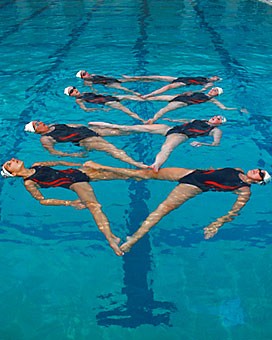The universe of club sports is described by its athletes again and again as an endeavor of passion. There are no scholarships available, funding for training and equipment is reduced and travel expenses are most often covered by the players themselves. Synchronized swimming at Arizona is no exception to the rule.
“”You have to love this sport to do it,”” said head coach Jill Ranucci. “”Think about being upside-down underwater for four minutes and not breathing.””
“”Syncro”” can be described as a cross-breed of swimming, gymnastics and ballet as individuals, duos, trios and teams perform water routines set to music. The sport combines artistry with the exceptional physical strength, endurance and coordination required to pull off complicated choreography in deep water.
“”Most people that have tried syncro who have played water polo or are speed swimmers have a lot of respect for the sport,”” Ranucci said. “”You have to smile and you have to point your toes and you have to look like you’re enjoying yourself even if you’re just dying.””
If you go
Arizona vs. Stanford
When: Friday
Time: 6:15 p.m.
and Saturday 11 a.m.
Where: Student Recreation Center
Said team president Carla Casalino: “”I have so many friends that have asked me to teach them how to (synchronize) swim, and they literally give up after five minutes of just me trying to teach them how to tread water. We really use every muscle in our body for every movement that we do.””
Many clubs put in long, devoted hours exercising their devotion to difficult and often unsung sports. If syncro is unexceptional in this respect, there is one thing that sets this team apart from its counterparts: While most teams labor in the shadow of their Division I equivalents, Arizona can rightfully say that it can swim with any team in the nation. Unlike most club sports, which see strict separation between varsity and club programs, NCAA syncro teams regularly face off against club programs across the country and compete in the same national championships.
Last year’s team placed seventh overall, higher than some varsity programs and first among all club teams.
This weekend, Arizona hosts the biggest fish in the pond – defending national champion Stanford.
For Arizona, you might expect the prospect of facing Stanford to be daunting. The Division I powerhouse regularly challenges for the national title and brings in many of the nation’s top prospects. However, the team maintains an upbeat attitude about the competition.
“”It’s a mix of feelings,”” said junior Rachel Ranucci, the coach’s daughter. “”It’s great when we can go to national championships and watch them because they’re absolutely amazing. Stanford will have Olympians on their team, and when they come here and swim we’ll get to see Olympians in our own pool.””
Arizona has its own Olympic-level swimmer in freshman Dayli Sepulveda. In 2004 she participated in Olympic qualifiers in Athens for her native Mexico.
Although her team qualified for the Olympics, Sepulveda did not participate in the official games. Sepulveda said one of the reasons was because she was 19 at the time and her coach considered her to be too young.
Sepulveda brings a high level of experience to Arizona’s team. She said it was not uncommon for her to practice eight hours a day, seven days a week during her time with the Mexican Olympic squad.
Now, as a member of Arizona’s club, Sepulveda takes a lead role in designing choreography for her new team.
“”I’m very creative,”” Sepulveda said. “”I listen to the music, and I have something in mind. I have a vision of something.””
But Sepulveda pointed out that choreography is a team effort, not just her own. The team will often offer contributions on what is working and what is not working.
“”All the team has to be involved in this because we’re swimming this,”” she said. “”It’s not just one.””
Said Rachel Ranucci: “”We listen to the music, and it’s whatever moves us. We bounce ideas off each other.””
Although coach Ranucci identifies Sepulveda as a kind of unofficial captain, it’s hard to identify a leader in the water because synchronized swimming is just that – synchronized. A successful team must be able to move together as one, and each athlete contributes an equal share of points when teams are judged. Everyone must do their part.
“”I’ve played so many team sports in my life, but I’ve never felt more of a team unity than in syncro,”” Casalino said.
“”If something happens in the water we don’t turn to Rachel and say, like, ‘Rachel, you’re our leader – tell us what to do,'”” she added.
Arizona hasn’t been home to a Division I synchronized swimming program since 1984. But synchronized swimming at Arizona has a proud history, with national championships in 1980, 1981 and 1984.
Although coach Ranucci admits that returning to first place against the likes of Stanford is unlikely, the team still sets its goals high with eyes on fifth place at this year’s nationals. That a high-powered team like Stanford is coming to the desert for a meet speaks volumes. Although Arizona’s club may not be varsity in its official title, or in the money it is offered, the team has maintained a varsity tradition.
Although this team may be exceptional in its high level of achievement, the greatest thrills are the ones common to all athletes. Regardless of whom they play, or where, for Arizona’s swimmers the greatest thrill is in the simple act of competing.
“”I can swim a routine a thousand times during practice, but the one time you have to swim during competition is always the best time,”” Casalino said.









